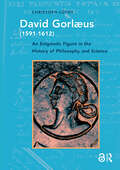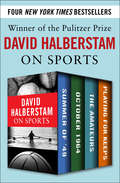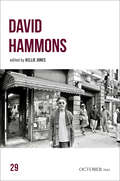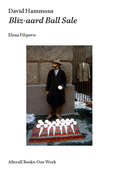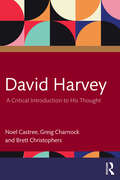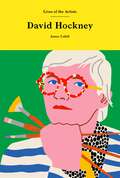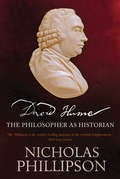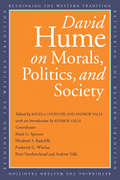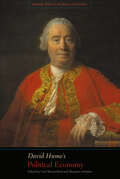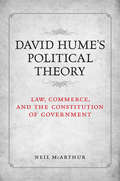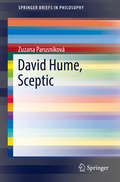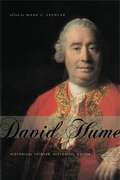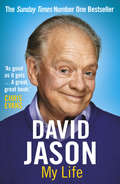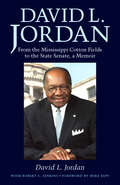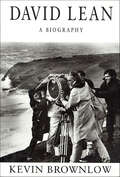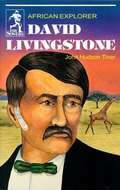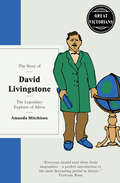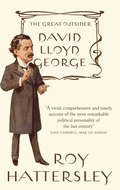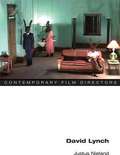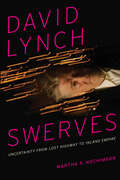- Table View
- List View
David Gorlaeus: An Enigmatic Figure in the History of Philosophy and Science (History of Science and Scholarship in the Netherlands)
by Christoph LüthyWhen David Gorlaeus (1591-1612) passed away at 21 years of age, he left behind two highly innovative manuscripts. Once they were published, his work had a remarkable impact on the evolution of seventeenth-century thought.,However, as his identity was unknown, divergent interpretations of their meaning quickly sprang up. Seventeenth-century readers understood him as an anti-Aristotelian thinker and as a precursor of Descartes. Twentieth-century historians depicted him as an atomist, natural scientist and even as a chemist. And yet, when Gorlaeus died, he was a beginning student in theology. His thought must in fact be placed at the intersection between philosophy, the nascent natural sciences, and theology.,The aim of this book is to shed light on Gorlaeus’ family circumstances, his education at Franeker and Leiden, and on the virulent Arminian crisis which provided the context within which his work was written. It also attempts to define Gorlaeus’ place in the history of Dutch philosophy and to assess the influence that it exercised in the evolution of philosophy and science, and notably in early Cartesian circles. Christoph Lüthy is professor of the history of philosophy and science at Radboud University Nijmegen, the Netherlands. Toen David Gorlaeus (1591-1612) op 21 jarige leeftijd overleed, liet hij twee baanbrekende manuscripten na. Na de postume publicatie in 1620 en 1651 hadden zijn werken een opmerkelijke invloed.,Doordat Gorlaeus’ identiteit onbekend was, ontstonden al snel zeer uiteenlopende interpretaties van de publicaties. Lezers uit de zeventiende eeuw dachten met een anti-aristotelische denker en een voorloper van Descartes van doen te hebben. Twintigste-eeuwse historici schilderden hem af als een atomist, natuurwetenschapper en zelfs als chemicus. Gorlaeus was echter 'slechts' beginnend theologiestudent en zijn werk bevindt zich op het kruispunt van filosofie, de ontluikende natuurwetenschappen en theologie.Dit boek beoogt inzicht te geven in de familieomstandigheden van Gorlaeus, zijn opleiding aan de universiteit van Franeker en Leiden en de historische context waarin hij zijn werk schreef. Ten slotte probeert de auteur te bepalen welke plaats Gorlaeus’ werken innemen in de geschiedenis van de Nederlandse filosofie en wat hun invloed was op de ontwikkelingen in filosofie en wetenschap.
David Halberstam on Sports: Summer of ’49, October 1964, The Amateurs, Playing for Keeps
by David HalberstamFour New York Times bestsellers by a “remarkable” Pulitzer Prize–winning journalist capture and celebrate America’s passion for sports (The Seattle Times). Pulitzer Prize–winning journalist David Halberstam, preeminent chronicler of the American experience, focuses his meticulous narrative gifts on some of Major League Baseball’s most iconic moments, training for the Olympics, and a remarkable profile of hoops legend Michael Jordan. Summer of ’49: In this #1 New York Times bestseller, Halberstam brings to stirring life the unforgettable season that cemented baseball as America’s pastime. A nation in transition is gripped by a pennant race for the ages: the Boston Red Sox, led by Ted Williams’s unearthly bat skills, versus the New York Yankees and Joe DiMaggio’s legendary heroics. Every hit on and off the field crackles across the page “in such an enjoyable, interesting, and informative manner that a reader needn’t be a baseball fan to appreciate the book” (Library Journal). October 1964: The 1964 World Series pitted the established Yankees against the upstart St. Louis Cardinals in an epic, seven-game seesaw battle that seemed to reflect the tensions of a nation in turmoil. The barnburner included a cast of legends—Mantle, Maris, Ford, Gibson, Brock—and enough game-changing plays to last a lifetime. Halberstam captures every moment with “a fluidity of writing that make[s] the reading almost effortless. . . . Absorbing” (San Francisco Chronicle). The Amateurs: This inspirational bestseller focuses Halberstam’s brilliant reportage on the travails and triumphs of Olympic rowing. Introducing us to a cast of highly driven athletes at the 1984 single sculls trials in Princeton, Halberstam delves deep into their struggles, motivations, and failures—but in the end only one will represent the United States at the 1984 Olympics in Los Angeles. Informative and compelling, Halberstam “maintains the suspense to the very last stroke” (Sports Illustrated). Playing for Keeps: A wildly entertaining and revealing portrait of global icon Michael Jordan and the rise of the NBA. With his usual impeccable research and gripping storytelling, Halberstam covers the whole court, from the transformative rivalry of Larry Bird and Magic Johnson to the invention of ESPN to Spike Lee’s Nike commercials to every unforgettable playoff game that built Jordan’s legend. “Filled with salty, informed hoops talk” (Publishers Weekly), this “remarkable book . . . [is] a must-read for basketball fans, admirers of Jordan, and anyone who seeks to understand sports in America today” (Bill Bradley).
David Hammons (October Files)
by Kellie JonesThe first anthology of texts on the luminary contemporary artist David Hammons.David Hammons is a collection of essays on the one of the most important living Black artists of our time, David Hammons (b. 1943). Documenting five decades of visual practice from 1982 to the present, the book features contributions from scholars, artists, and cultural workers, and includes numerous images of the artist and his work that are not widely available. Contributions include essays from cultural critics including Guy Trebay and Greg Tate; artists Coco Fusco and Glenn Ligon; and scholars such as Robert Farris Thompson, Alex Alberro, and Manthia Diawara.A star of the West Coast Black Arts Movement in the 1960s and the winner of a Prix de Rome prize as well as a MacArthur Fellowship, David Hammons rose to fame in Los Angeles with his body prints, in which he used his entire body as a printing plate. His later work engaged with materials that he found in urban environments—from greasy brown paper bags, discarded hair from barber shops, and empty bottles of cheap wine—which he turned into things of wonder while also commenting on a country&’s neglect of its citizens. In this volume, a new generation of scholars, Tobias Wofford, Abbe Schriber, and Sampada Aranke, broaden the theoretical mapping of Hammons&’s career and its impact, challenging viewers to imagine, in the words of Aranke, &“how to see like Hammons.&”
David Hammons: Bliz-aard Ball Sale (Afterall Books / One Work)
by Elena FilipovicDrawing on unpublished documents and oral histories, an illustrated examination of an iconic artwork of an artist who has made a lifework of tactical evasion.One wintry day in 1983, alongside other street sellers in the East Village, David Hammons peddled snowballs of various sizes. He had neatly laid them out in graduated rows and spent the day acting as obliging salesman. He called the evanescent and unannounced street action Bliz-aard Ball Sale, thus inscribing it into a body of work that, from the late 1960s to the present, has used a lexicon of ephemeral actions and self-consciously “black" materials to comment on the nature of the artwork, the art world, and race in America. And although Bliz-aard Ball Sale has been frequently cited and is increasingly influential, it has long been known only through a mix of eyewitness rumors and a handful of photographs. Its details were as elusive as the artist himself; even its exact date was unrecorded. Like so much of the artist's work, it was conceived, it seems, to slip between our fingers—to trouble the grasp of the market, as much as of history and knowability.In this engaging study, Elena Filipovic collects a vast oral history of the ephemeral action, uncovering rare images and documents, and giving us singular insight into an artist who made an art of making himself difficult to find. And through it, she reveals Bliz-aard Ball Sale to be the backbone of a radical artistic oeuvre that transforms such notions as “art,” “commodity,” “performance,” and even “race” into categories that shift and dissolve, much like slowly melting snowballs.
David Harvey: A Critical Introduction to His Thought
by Brett Christophers Noel Castree Greig CharnockDavid Harvey is among the most influential Marxist thinkers of the last half century. This book offers a lucid and authoritative introduction to his work, with a structure designed to reflect the enduring topics and insights that serve to unify Harvey’s writings over a long period of time. Harvey’s writings have exerted huge influence within the social sciences and the humanities. In addition, his work now commands a global readership among Left political activists and those interested in current world affairs. Harvey’s central preoccupation is capitalism and the impacts of its growth-obsessed, contradictory dynamics. His name is synonymous with key analytical concepts like ‘the spatial fix’ and ‘accumulation by dispossession’. This critical introduction to his thought is an essential companion for both new and more experienced readers. The critique of capitalism is one of the most important undertakings of our time, and Harvey’s work offers powerful tools to help us see why a ‘softer’ capitalism is insufficient and a post-capitalist future is necessary. This book is an important resource for scholars and graduate students in geography, politics and many other disciplines across the social sciences and humanities.
David Hockney (Lives of the Artists)
by James CahillThe latest addition to the 'Lives of the Artists' series: highly readable short biographies of the world's greatest artistsDavid Hockney is the most famous living British artist. And he is arguably one of the more famous American artists as well. Emerging from the north of England in the 1960s, he made quite a splash in Swinging London as a portaitist, and went on to make a even bigger splash in Los Angeles when he moved there in the 1970s. His figurative paintings of the 1970s and 1980s captured the zeitgeist of West Coast living, while he also explored new avenues by constructing mosaics out of polaroids. By the beginning of the millennium, he returned to his Yorkshire roots, embarking on a new period of painting. This came to an end with the death by misadventure in his home of a young studio assistant in 2013. He went 'home' to LA and has in the intervening years begun a new period of contemplative portraiture.
David Hockney (Lives of the Artists)
by James CahillThe latest addition to the 'Lives of the Artists' series: highly readable short biographies of the world's greatest artistsDavid Hockney is the most famous living British artist. And he is arguably one of the more famous American artists as well. Emerging from the north of England in the 1960s, he made quite a splash in Swinging London as a portaitist, and went on to make a even bigger splash in Los Angeles when he moved there in the 1970s. His figurative paintings of the 1970s and 1980s captured the zeitgeist of West Coast living, while he also explored new avenues by constructing mosaics out of polaroids. By the beginning of the millennium, he returned to his Yorkshire roots, embarking on a new period of painting. This came to an end with the death by misadventure in his home of a young studio assistant in 2013. He went 'home' to LA and has in the intervening years begun a new period of contemplative portraiture.
David Hume
by Nicholas PhillipsonA giant of the eighteenth-century Enlightenment, David Hume was one of the most important philosophers ever to write in English. He was also a brilliant historian. In this book—a new and revised edition of his 1989 classic—Nicholas Phillipson shows how Hume freed history from religion and politics. As a philosopher, Hume sought a way of seeing the world and pursuing happiness independently of a belief in God. His groundbreaking approach applied the same outlook to Britain's history, showing how the past was shaped solely through human choices and actions. In this analysis of Hume's life and works, from his university days in Edinburgh to the rapturous reception of his History of England, Nicholas Phillipson reveals the gradual process by which one of the greatest Western philosophers turned himself into one of the greatest historians of Britain. In doing so, he shows us how revolutionary Hume was, and why his ideas still matter today.
David Hume on Morals, Politics, and Society (Rethinking the Western Tradition)
by David Hume Angela Coventry Andrew VallsA compact and accessible edition of Hume’s political and moral writings with essays by a distinguished set of contributors A key figure of the Scottish Enlightenment, David Hume was a major influence on thinkers ranging from Kant and Schopenhauer to Einstein and Popper, and his writings continue to be deeply relevant today. With four essays by leading Hume scholars exploring his complex intellectual legacy, this volume presents an overview of Hume’s moral, political, and social philosophy. Editors Angela Coventry and Andrew Valls bring together a selection of writings from Hume’s most important works, with contributors placing them in their appropriate context and offering a lively discourse on the relevance of Hume’s thought to contemporary subjects like reason’s dependence on emotion and the importance of social convention in political and economic behavior. Perfect for classroom use, this volume is an invaluable companion for anyone studying an important thinker who advanced the development of moral philosophy, economics, cognitive science, and many other fields of the Western tradition.
David Hume's Political Economy
by Margaret Schabas Carl WennerlindHume‘s Political Discourses (1752) won immediate acclaim and positioned him as an authoritative figure on the subject of political economy. This volume of thirteen new essays definitively establishes the central place of political economy in Hume‘s intellectual endeavor, as well as the profound and far-reaching influence of his theories on Enlighte
David Hume's Political Theory: Law, Commerce and the Constitution of Government
by Neil McarthurDavid Hume (1711-1776) is perhaps best known for his treatises on problems of epistemology, skepticism, and causation. A less familiar side of his intellectual output is his work on legal and political theory. David Hume's Political Theory brings together Hume's diverse writings on law and government, collected and examined with a view to revealing the philosopher's coherent and persuasive theory of politics.Through close textual analysis, Neil McArthur suggests that the key to Hume's political theory lies in its distinction between barbarous and civilized government. Throughout the study, the author explores Hume's argument that a society's progress from barbarism to civilization depends on the legal and political system by which it is governed. Ultimately, McArthur demonstrates that the skepticism apparent in much of Hume's work does not necessarily tie him to a strict conservative ideology; rather, Hume's political theory is seen to emphasize many liberal virtues as well.Based on a new conception of Hume's political philosophy, this is a groundbreaking work and a welcome addition to the existing literature.
David Hume, Sceptic (SpringerBriefs in Philosophy)
by Zuzana ParusnikováThis book studies Hume’s scepticism and its roots, context, and role in the philosopher’s life. It relates how Hume wrote his philosophy in a time of tumult, as the millennia-old metaphysical tradition that placed humans and their cognitive abilities in an ontological framework collapsed and gave way to one that placed the autonomy of the individual in its center. It then discusses the birth of modernity that Descartes inaugurated and Kant completed with his Copernican revolution that moved philosophy from Being to the Self. It shows how modernity gave rise to a new kind of scepticism, involving doubt not just about the adequacy of our knowledge but about the very existence of a world independent of the self. The book then examines how Hume faced the sceptical implications and how his empiricism added yet another sceptical theme with the main question being how argument can legitimize key concepts of human understanding instinctively used in making sense of our perceptions. Placing it firmly in a historical context, the book shows how Hume was influenced by Pyrrhonian scepticism and how this becomes clear in Hume’s acceptance of the weakness of reason and in his emphasis on the practical role of philosophy. As the book argues, rather than serving as the foundation of science, in Hume’s hand, philosophy became a guide to a joyful, happy life, to a documentary of common life and to moderately educated, entertaining conversation. This way Hume stands in strong opposition to the (early) modern mainstream.
David Hume: Historical Thinker, Historical Writer
by Mark G. SpencerThis volume provides a new and nuanced appreciation of David Hume as a historian. Gone for good are the days when one can offhandedly assert, as R. G. Collingwood once did, that Hume “deserted philosophical studies in favour of historical” ones. History and philosophy are commensurate in Hume’s thought and works from the beginning to the end. Only by recognizing this can we begin to make sense of Hume’s canon as a whole and see clearly his many contributions to fields we now recognize as the distinct disciplines of history, philosophy, political science, economics, literature, religious studies, and much else besides. Casting their individual beams of light on various nooks and crannies of Hume’s historical thought and writing, the book’s contributors illuminate the whole in a way that would not be possible from the perspective of a single-authored study.Aside from the editor, the contributors are David Allan, M. A. Box, Timothy M. Costelloe, Roger L. Emerson, Jennifer Herdt, Philip Hicks, Douglas Long, Claudia M. Schmidt, Michael Silverthorne, Jeffrey M. Suderman, Mark R. M. Towsey, and F. L. van Holthoon.
David Hume: Historical Thinker, Historical Writer
by Mark G. SpencerThis volume provides a new and nuanced appreciation of David Hume as a historian. Gone for good are the days when one can offhandedly assert, as R. G. Collingwood once did, that Hume “deserted philosophical studies in favour of historical” ones. History and philosophy are commensurate in Hume’s thought and works from the beginning to the end. Only by recognizing this can we begin to make sense of Hume’s canon as a whole and see clearly his many contributions to fields we now recognize as the distinct disciplines of history, philosophy, political science, economics, literature, religious studies, and much else besides. Casting their individual beams of light on various nooks and crannies of Hume’s historical thought and writing, the book’s contributors illuminate the whole in a way that would not be possible from the perspective of a single-authored study.Aside from the editor, the contributors are David Allan, M. A. Box, Timothy M. Costelloe, Roger L. Emerson, Jennifer Herdt, Philip Hicks, Douglas Long, Claudia M. Schmidt, Michael Silverthorne, Jeffrey M. Suderman, Mark R. M. Towsey, and F. L. van Holthoon.
David Jason: My Life
by David JasonWinner of the National Book Awards Autobiography of the YearThe long-awaited autobiography of one of Britain's best-loved actors*As seen in David and Jay’s Touring Toolshed on BBC Two*Born the son of a Billingsgate market porter at the height of the Second World War, David Jason spent his early life dodging bombs and bullies, both with impish good timing. Giving up on an unloved career as an electrician, he turned his attention to acting and soon, through a natural talent for making people laugh, found himself working with the leading lights of British comedy in the 1960s and '70s: Eric Idle, Michael Palin, Bob Monkhouse and Ronnie Barker. Barker would become a mentor to David, leading to hugely successful stints in Porridge and Open All Hours.It wasn't until 1981, kitted out with a sheepskin jacket, a flat cap, and a clapped-out Reliant Regal, that David found the part that would capture the nation's hearts: the beloved Derek 'Del Boy' Trotter in Only Fools and Horses. Never a one-trick pony, he had an award-winning spell as TV's favourite detective Jack Frost, took a country jaunt as Pop Larkin in the Darling Buds of May, and even voiced a crime-fighting cartoon rodent in the much-loved children's show Danger Mouse.But life hasn't all been so easy: from missing out on a key role in Dad's Army to nearly drowning in a freak diving accident, David has had his fair share of ups and downs, and has lost some of his nearest and dearest along the way.David's is a touching, funny and warm-hearted story, which charts the course of his incredible five decades at the top of the entertainment business. He's been a shopkeeper and a detective inspector, a crime-fighter and a market trader, and he ain't finished yet. As Del Boy would say, it's all cushty.
David Joins the California Gold Rush
by Linda SibleyFinding gold is David's dream when he and his family join the California Gold Rush in 1849. David quickly learns that panning for gold is hard work, and is about to give up when he accidentally discovers gold. Will he keep the gold for himself or give it to a slave to buy his family's freedom? Ages 9-12.
David L. Jordan: From the Mississippi Cotton Fields to the State Senate, a Memoir (Willie Morris Books in Memoir and Biography)
by David L. JordanIn David L. Jordan's earliest memories, he is lying in the fields, the black earth beneath him and the sky and sun above, filtered through the leaves of the cotton plants. The youngest of five children in a family of sharecroppers, he was nursed and grew up in those fields, joining his family in their work as soon as he was old enough to carry a sack. David L. Jordan: From the Mississippi Cotton Fields to the State Senate is the memoir of black Mississippi state senator and city councilman Jordan. His life in twentieth-century Mississippi spanned some of the most difficult times for black Mississippians as they coped with the effects of crippling economic circumstances caused by tenant farming and second-class citizenship enforced through the most violent and repressive means. Jordan shares his experiences from early childhood growing up in Leflore County, the heart of the Mississippi Delta, through his life and work in government. He rose from humble beginnings to become professional educator and eventually one of the Deep South's most recognizable social and political activists. In this revealing autobiography, Jordan describes his witness to the often brutal and humiliating mistreatment of blacks by white racists. He is one of the few persons still alive who attended the sensational trial of the two white men accused of the horrific lynching of Emmett Till in 1955. Jordan recounts the atmosphere and drama surrounding the case with telling effects, shining light on this brand of Mississippi injustice that will help readers understand why many people consider the case the real genesis of the modern civil rights movement. Though change was often slow and grudging, Jordan's Mississippi has evolved and continues to overcome. Indeed, Jordan's story is notably a revelation of his role as a catalyst in shaping many of the gains that blacks have achieved in Mississippi in the past fifty years. With a deep belief in the power of education, hard work, and determination, Jordan has worked tirelessly and courageously so that all his fellow citizens might enjoy the human and political rights he has long championed.
David Lean: A Biography
by Kevin BrownlowThe life and its biographer provide a landmark work on the cinema. Emerging from a childhood of nearly Dickensian darkness, David Lean found his great success as a director of the appropriately titled Great Expectations.There followed his legendary black-and-white films of the 1940s and his four-film movie collaboration with Noel Coward. Lean's 1955 film Summertime took him from England to the world of international moviemaking and the stunning series of spectacular color epics that would gain for his work twenty-seven Academy Awards and fifty-six Academy Award nominations. All are classics, including The Bridge on the River Kwai, Lawrence of Arabia, Doctor Zhivago, and A Passage to India.Kevin Brownlow, a film editor in his own right and author of the seminal silent film trilogy initiated with The Parade's Gone By. . ., brings to Lean's biography an exhaustive knowledge of the art and the industry.One learns about the making of movies as realized by a master, but also of the highly personal costs of genius. The troubled Quaker family from which Lean came influenced his relationship with his son, his brother, and his six wives. Yet he showed in his work a deep understanding of humanity.The vastness of this scholarly and entertaining enterprise is augmented by sixteen pages of scenes from Lean's color films, thirty-two pages from his black-and-white movies, and throughout the text a vast number of photographs from his life and location work.
David Livingstone: African Explorer (Sower Ser.sower Series Biographies)
by John H. Tiner Diane Davis Joyce Bohn Rebecca BooherDavid Livingstone was one of the greatest explorers who ever lived, and his exciting exploits in Africa tell a story of unsurpassed courage and determination.
David Livingstone: The Legendary Explorer Of Africa (Great Victorians)
by Amanda MitchisonBorn a poor Glasgow cotton-mill worker, David grew up to become a great explorer and hero of his time.This is his incredible story. The tough man of Victorian Britain would stop at nothing in his determination to be the first white man to explore Africa, even if it meant dragging his wife and children along with him.He trekked hundreds of miles through dangerous territory, braving terrible illness and pain, and was attacked by cannibals, rampaging lions and killer ants…Short Books is re-releasing some of its finest writing as a newly designed series of six children’s biographies called The Great Victorians. These are entertaining and engaging stories of some of history’s most fascinating characters. They tell history in a novelistic, engaging way, a halfway house between storybooks and traditional history. There is abundant humour and drama too.With beautifully designed covers these books will catch the eyes of parents as well as children. Also published in a highly collectable set.
David Lloyd George: The Great Outsider
by Roy HattersleyA Welshman among the English, a nonconformist among Anglicans and a self-made man in the patrician corridors of power, David Lloyd George, the last Liberal Prime Minister of Great Britain, was the founding father of the Welfare State and was as great a peacetime leader as Churchill was in war. In this fascinating biography of an authentic radical, Roy Hattersley charts the great reforms - the first old age pension, sick pay and unemployment benefit - of which Lloyd George was architect, and also sheds light on the complexities of a man who was both a tireless champion of the poor, and a restless philanderer who was addicted to living dangerously.
David Lloyd George: The Great Outsider
by Roy HattersleyA Welshman among the English, a nonconformist among Anglicans and a self-made man in the patrician corridors of power, David Lloyd George, the last Liberal Prime Minister of Great Britain, was the founding father of the Welfare State and was as great a peacetime leader as Churchill was in war. In this fascinating biography of an authentic radical, Roy Hattersley charts the great reforms - the first old age pension, sick pay and unemployment benefit - of which Lloyd George was architect, and also sheds light on the complexities of a man who was both a tireless champion of the poor, and a restless philanderer who was addicted to living dangerously.
David Lynch (Contemporary Film Directors)
by Justus NielandA key figure in the ongoing legacy of modern cinema, David Lynch designs environments for spectators, transporting them to inner worlds built by mood, texture, and uneasy artifice. We enter these famously cinematic interiors to be wrapped in plastic, the fundamental substance of Lynch's work. This volume revels in the weird dynamism of Lynch's plastic worlds. Exploring the range of modern design idioms that inform Lynch's films and signature mise-en-scène, Justus Nieland argues that plastic is at once a key architectural and interior design dynamic in Lynch's films, an uncertain way of feeling essential to Lynch's art, and the prime matter of Lynch's strange picture of the human organism. Nieland's study offers striking new readings of Lynch's major works (Eraserhead, Blue Velvet, Wild at Heart, Mulholland Dr., Inland Empire) and his early experimental films, placing Lynch's experimentalism within the aesthetic traditions of modernism and the avant-garde; the genres of melodrama, film noir, and art cinema; architecture and design history; and contemporary debates about cinematic ontology in the wake of the digital. This inventive study argues that Lynch's plastic concept of life--supplemented by technology, media, and sensuous networks of an electric world--is more alive today than ever.
David Lynch Swerves: Uncertainty from Lost Highway to Inland Empire
by Martha P. NochimsonA study of the role of quantum physics and the Holy Vedas in the later works of filmmaker David Lynch.“The richness of Nochimson’s writing, the thoroughness of her interpretation, and her assured stance in opposition to the canon of Lynch criticism to date all make David Lynch Swerves a must-read for anyone interested in the films of David Lynch. Or, for that matter, the state of film criticism in American culture. If criticism at its best is a form of revelation, then this is practically a new gospel.”―House of SpeakEasyBeginning with Lost Highway, director David Lynch “swerved” in a new direction, one in which very disorienting images of the physical world take center stage in his films. Seeking to understand this unusual emphasis in his work, noted Lynch scholar Martha Nochimson engaged Lynch in a long conversation of unprecedented openness, during which he shared his vision of the physical world as an uncertain place that masks important universal realities. He described how he derives this vision from the Holy Vedas of the Hindu religion, as well as from his layman’s fascination with modern physics.With this deep insight, Nochimson forges a startlingly original template for analyzing Lynch’s later films—the seemingly unlikely combination of the spiritual landscape envisioned in the Holy Vedas and the material landscape evoked by quantum mechanics and relativity. In David Lynch Swerves, Nochimson navigates the complexities of Lost Highway, The Straight Story, Mulholland Drive, and Inland Empire with uncanny skill, shedding light on the beauty of their organic compositions; their thematic critiques of the immense dangers of modern materialism; and their hopeful conceptions of human potential. She concludes with excerpts from the wide-ranging interview in which Lynch discussed his vision with her, as well as an interview with Columbia University physicist David Albert, who was one of Nochimson’s principal tutors in the discipline of quantum physics.“The book succeeds in making more sense of Lynch's more puzzling works . . .Recommended.” —Library Journal“This book is nothing less than a revelation of a new David Lynch . . .so convincing are the book’s claims, so well-substantiated and explained. . . . The focus on the physics of Lynch is a true paradigm shift in our understanding of the director. Nothing will ever be the same in Lynch studies again.” —Eric G. Wilson, Professor of English, Wake Forest University, author of The Strange World of David Lynch: Transcendental Irony from Eraserhead to Mulholland Dr.
